Flower Delivery Services Market Research, 2031
The global flower delivery services market was valued at $5.7 billion in 2021, and is projected to reach $10.1 billion by 2031, growing at a CAGR of 5.9% from 2022 to 2031.
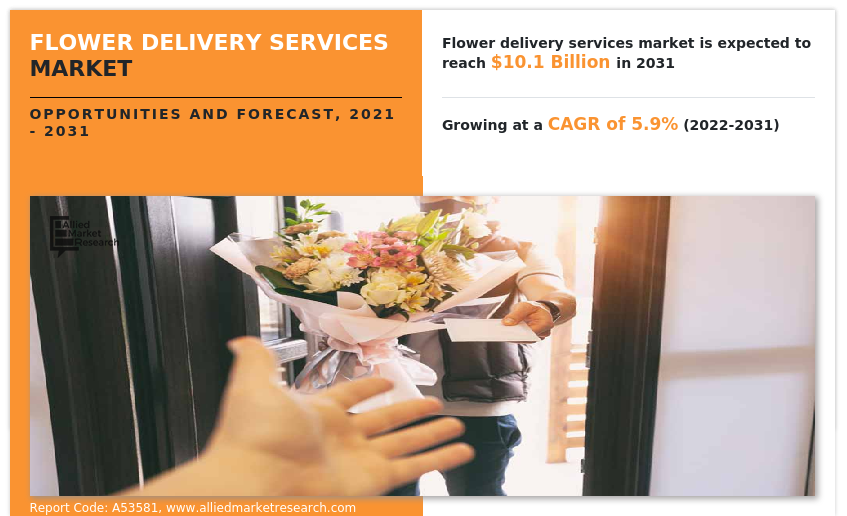
The flower delivery services market refers to the business of providing floral arrangements and bouquets for customers to order and delivered to a specified location. This market encompasses a variety of businesses, including traditional florists, online flower delivery services, and subscription-based services.
The flower delivery services industry has grown significantly in recent years due to the convenience and accessibility offered by online ordering and delivery options. Customers can browse and select from a wide range of floral arrangements, often with customizable options for specific occasions or preferences.
In addition to serving individual customers, flower delivery services also cater to corporate clients for events and functions, such as weddings, conferences, and fundraisers. The market is highly competitive, with numerous players offering varying levels of quality, pricing, and customer service.
The overall impact of COVID-19 on the flower delivery services market has been mixed, with both positive and negative effects. The initial impact was negative, with temporary closures and decreased demand due to disruptions in supply chains and consumer behavior changes. However, as the pandemic continued, there was an increase in demand for flowers as people looked for ways to brighten their homes and show support to loved ones they could not visit in person. Additionally, the shift towards online ordering and delivery has accelerated, leading to an expansion of the market and new opportunities for growth. Overall, while there have been challenges, the flower delivery services market has shown resilience and adaptability in response to changing consumer needs and preferences during the pandemic. While the full extent of the long-term impact of COVID-19 on the flower delivery services market is uncertain, the industry is likely to continue to evolve and adapt in response to changing market conditions and consumer behavior.
Fresh-cut flowers are commonly used for decoration to beautify spaces. They are an integral part of celebrations such as weddings, birthday parties, and festivals. They are used for gifting to someone to show love & care and for decorating homes & commercial spaces. They can be organized into flower wreaths, bouquets, and corsages. Floral arrangements and other decorations can improve the comfort and visitor-friendly atmosphere in hotels and resorts. The hotel sector may benefit from adding a personal touch through flower arrangements. Visitors value flowers because they add a sense of freshness to the environment. It is anticipated that the expansion of the hospitality industry would further increase the consumer demand of flowers which is expected to boost the flower delivery services market size.
Recently, a worrying trend of growth of new deadly diseases year on year has been observed by the world. Deadly diseases such as COVID-19, SARS, MERS-COV, EBOLA, H1N1, and others, not only cease economic activities but also bring humans to a standstill. During the outbreak of these diseases, humans are forced to isolate from the rest of society to stop the spread. These diseases have forced consumers to shop online for their needs. Because of social disconnect and the necessity to avoid human-to-human interaction, it becomes extremely difficult for someone to purchase flowers through conventional stores.
The rising environmental concern among the global population is expected to hamper the growth of flower delivery services. Cut flowers are needed to be delivered fresh and according to an article by the Green Journal the refrigeration process causes trucks to burn more fuel, and they emit greater carbon dioxide into the atmosphere. On average, refrigerated trucks use about 25% more fuel than those that are not refrigerated, and one must keep in mind that most trucks in the US still run on diesel which produces more air pollutants than gasoline. Such harm of cut flowers to the environment may hamper the growth of the market as consumers are more concerned about the environmental harm owing to which consumers might restrain themselves from buying cut flowers. which can have a negative impact on the flower delivery services market demand.
Flowers have a positive impact on the mind of an individual which is expected to create an opportunity for the growth of the flower delivery services market. For instance, according to the report of the National Library of Medicine, the results suggest that 3 min of observation and meditation on yellow or red flowers might have strong positive immediate impacts on individuals’ well-being. The findings support the notion that seeing flowers can provide physiological and psychological advantages such as stress reduction and improved well-being. While flowers have a positive effect on people, the color of the flower impacts those positive effects as well. The yellow flowers were most capable of improving the participants’ feelings of relaxation compared to the red and white flowers. Such a positive impact of flowers on humans is expected to further propel the flower delivery services market growth.
The flower delivery services market is analyzed based on the flower type, end-user, occasion, and region. By flower type, the market is segmented into roses, carnations, orchids, gerberas, and tulips. By end-user, the market is classified into commercial and household. On the basis of Occasion, the market is categorized into personal & gifting, wedding, corporate, and sympathy. The personal & gifting segment is further bifurcated into birthdays, anniversaries, and love and romance. Region-wise, the market is analyzed across North America, Europe, Asia-Pacific, and LAMEA.
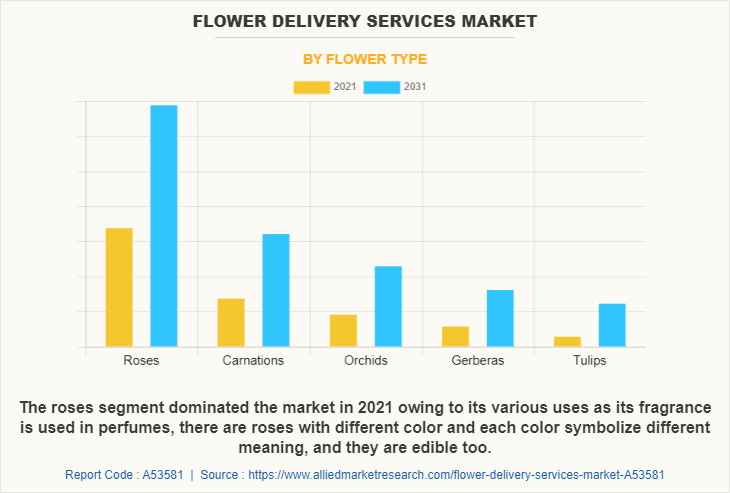
On the basis of flower type, the flower delivery services market is further bifurcated into roses, carnations, orchids, gerberas, and tulips. The rose segment accounted for the majority of the global flower delivery services market share. The rose segment is expected to grow at a significant CAGR owing to various uses such as its fragrance is used in perfumes, there are roses with different color and each color symbolize different meaning, and they are edible too. Persian cuisines have an abundant use of rose petals, especially when it comes to salads. Other than Persian cuisine, Turkish delight is also a good example of a rose-flavored sweet treat. Such usage of rose is expected to further propel the demand for the segment.
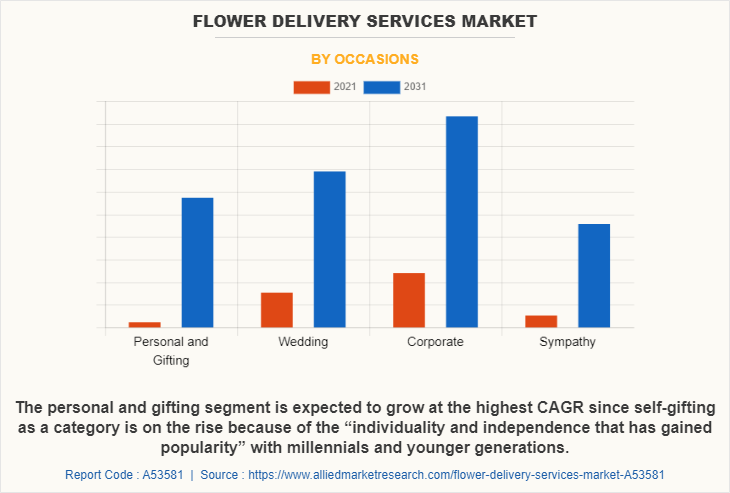
On the basis of occasion, the flower delivery services market is further segmented into personal & gifting, wedding, corporate, and sympathy. The personal & gifting segment is further bifurcated into birthdays, anniversaries, and love and romance. The personal & gifting segment is expected to witness the highest growth during the flower delivery services market forecast period since self-gifting as a category is on the rise because of the “individuality and independence that has gained popularity” with millennials and younger generations.
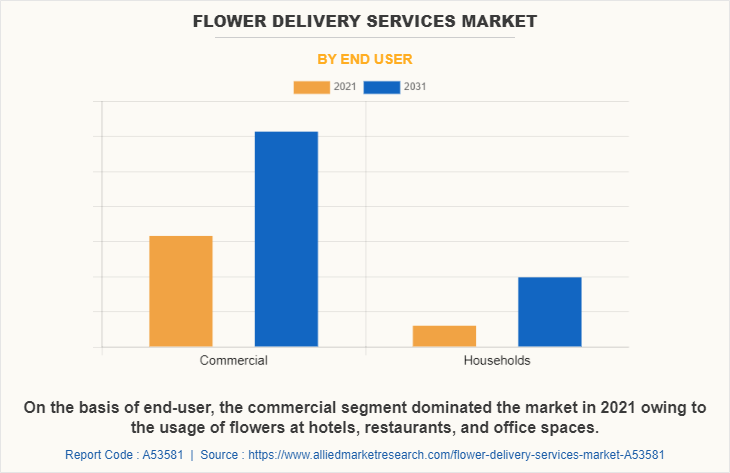
On the basis of end-user, the flower delivery services market is further bifurcated into commercial and household. The commercial segment dominated the market in 2021 and is expected to maintain its dominance during the forecast period owing to the appealing look flowers give to attract more consumers and make the commercial place look appealing. Along with this the rise in the HoReCa, commercial meetings after the pandemic, and others are expected to further propel the market size. The households segment is expected to witness the highest growth owing to the positive impact of flowers on the human mind. For instance, according to the report of the National Library of Medicine, the results suggest that 3 min of observation and meditation on yellow or red flowers might have strong positive immediate impacts on individuals’ well-being.
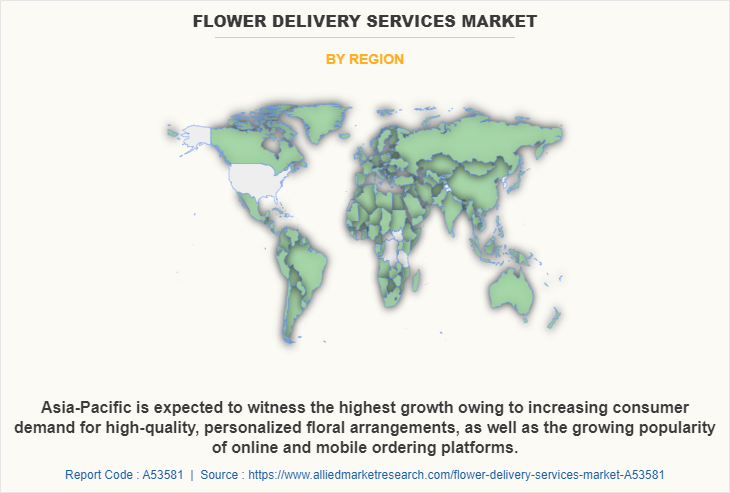
For the market analysis, on the basis of region, the market is further segmented into North America (the U.S., Canada, and Mexico), Europe (Germany, UK, France, Italy, Spain, and the Rest of Europe), Asia-Pacific (China, Japan, India, Australia, Indonesia, New Zealand, and the rest of Asia-Pacific), and LAMEA (Brazil, Argentina, Saudi Arabia, South Africa, and the rest of LAMEA). Asia-Pacific is expected to witness the highest growth owing to the rise in consumer awareness regarding self-care and self-gifting with rising disposable income.
The key leading players operating in this market include The Bouqs Company, 1-800-FLOWERS.COM, Farmgirl Flowers, Teleflora, Venus et fleur, The Sill, UrbanStems, Ferns n Petals Pvt. Ltd, Floward, and Bloomex. The market players have adopted various strategies such as product launch, collaboration, acquisition, expansion and partnership.
Key Benefits For Stakeholders
- This report provides a quantitative analysis of the market segments, current trends, estimations, and dynamics of the flower delivery services market analysis from 2021 to 2031 to identify the prevailing flower delivery services market opportunities.
- The market research is offered along with information related to key drivers, restraints, and opportunities.
- Porter's five forces analysis highlights the potency of buyers and suppliers to enable stakeholders make profit-oriented business decisions and strengthen their supplier-buyer network.
- In-depth analysis of the flower delivery services market segmentation assists to determine the prevailing market opportunities.
- Major countries in each region are mapped according to their revenue contribution to the global market.
- Market player positioning facilitates benchmarking and provides a clear understanding of the present position of the market players.
- The report includes the analysis of the regional as well as global flower delivery services market trends, key players, market segments, application areas, and market growth strategies.
Flower Delivery Services Market Report Highlights
| Aspects | Details |
| Market Size By 2031 | USD 10.1 billion |
| Growth Rate | CAGR of 5.9% |
| Forecast period | 2021 - 2031 |
| Report Pages | 245 |
| By Flower Type |
|
| By Occasions |
|
| By End user |
|
| By Region |
|
| Key Market Players | The Sill, Inc., Venus ET Fleur, Farmgirl Flowers, Inc., 1-800-FLOWERS.COM, Inc, The Wonderful Company LLC., The Bouqs Company, FNP E Retail Private Limited, Bloomex, UrbanStems, Inc., Floward |
Analyst Review
According to the CXO, the flower delivery services market has grown significantly in recent years owing to the convenience and accessibility offered by online ordering and delivery options. Customers can browse and select from a wide range of floral arrangements, often with customizable options for specific occasions or preferences.
In addition to serving individual customers, flower delivery services also cater to corporate clients for events and functions, such as weddings, conferences, and fundraisers. The market is highly competitive, with numerous players offering varying levels of quality, pricing, and customer service.
The Flower Delivery Services Market was valued at $5,742.80 million in 2021 and is estimated to reach $10,107.70 million by 2031.
The global flower delivery services market registered a CAGR of 5.9% from 2022 to 2031.
Raise the query and paste the link of the specific report and our sales executive will revert with the sample.
The forecast period in the flower delivery services market report is from 2022 to 2031.
The major players operating in the global flower delivery services industry are The Bouqs Company, 1-800-FLOWERS.COM, Farmgirl Flowers, Teleflora, Venus et fleur, The Sill, UrbanStems, Ferns n Petals Pvt. Ltd, Floward, and Bloomex.
The flower delivery services market is segmented on the basis of flower type, occasions, end-user, and region.
The initial impact of COVID-19 was negative, with temporary closures and decreased demand due to disruptions in supply chains and consumer behavior changes. However, as the pandemic continued, there was an increase in demand for flowers as people looked for ways to brighten their homes and show support to loved ones they could not visit in person. Additionally, the shift towards online ordering and delivery has accelerated, leading to an expansion of the market and new opportunities for growth.
Asia-Pacific is expected to witness the highest growth during the forecast period.
Loading Table Of Content...


